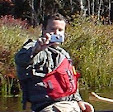Know the Weather Forecast
Modern weather forecasting is extremely accurate, so be sure to check the forecast before paddling. If the forecast calls for some chance of thunderstorms, cancel or postpone your trip and go another day – better safe than sorry.
Watch for Developing Thunderstorms
Even on the water it is a good idea to watch for storms. Thunderstorms are most likely to develop on warm summer days and go through several stages of growth, development and dissipation. On a sunny day, as the sun heats the air, pockets of warmer air start to rise in the atmosphere. When this air reaches a certain level in the atmosphere, cumulus clouds start to form. Continued heating can cause these clouds to grow vertically upward in the atmosphere into "towering cumulus" clouds. These towering cumulus may be one of the first indications of a developing thunderstorm.
Approaching Thunderstorms: When to Seek Shelter
If you can hear thunder, you are within striking distance of lightning, and should seek shelter immediately! The first stroke of lightning is just as deadly as the last. If the sky looks threatening, take shelter before hearing thunder. You can get struck by a storm that’s up to 10 miles away.
The 30-30 Rule
Use the 30-30 rule where visibility is good and there is nothing obstructing your view of the thunderstorm. When you see lightning, count the time until you hear thunder. If that time is 30 seconds or less, the thunderstorm is within 6 miles of you, and is extremely dangerous!
The threat of lightning continues for much longer than most people realize. Take shelter as soon as you hear thunder, and wait at least 30 minutes after the last clap of thunder before leaving. Don't be fooled by sunshine or blue sky!
Outdoor Activities: Minimize the Risk of Being Struck
During a thunderstorm, each flash of cloud-to-ground lightning is a potential killer. In addition to the visible flash that travels through the air, the current associated with the lightning discharge travels along the ground. Although some victims are struck directly by the main lightning bolt, many more victims are struck as the current moves in and along the ground.
There is no safe place outside in a thunderstorm. The only way to significantly reduce your risk is to get inside a substantial building or automobile as fast as you can. If you are stuck outside in a thunderstorm, you should avoid the following:
- Open areas including water – you don’t want to be the tallest object in the area.
- Hills, isolated trees, towers or utility poles - lightning tends to strike these taller objects.
- Metal conductors such as wires or fences - metal does not attract lightning, but lightning can travel for long distances through it.
Crouching Can Help—But Lying Down Makes Things Worse
If you find yourself in a situation where you are exposed to the elements with nowhere to shelter, make yourself as small a target as possible. Crouch down with your feet together, hands on knees and your head tucked in. Don’t lay down on the ground. You want as little of yourself in contact with the ground as possible.
Be Prepared
Check the forecast, and cancel or postpone your trip if lightning is a threat. In the event of a storm, fully enclosed buildings with wiring and plumbing provide the best protection. If a sturdy building is not available, get into a car and close all the windows. Stay inside for 30 minutes after the last rumble of thunder.
Links:
















































